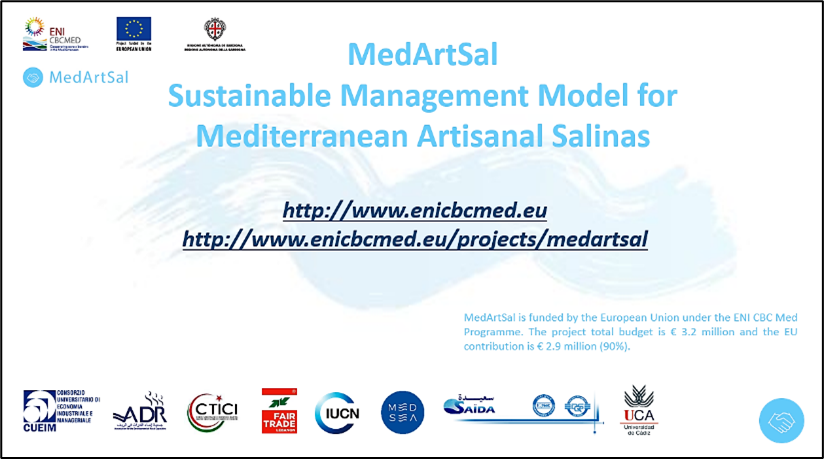MedArtSal and the Interreg Blue Growth projects: common values and synergies opportunities to capitalize on successful experiences in the Med Region

In the framework of MedArtSal project, with the aim of discovering and developing new possible synergies with other programmes and projects, last 13th December 2022 CUEIM, as MedArtSal Lead Beneficiary, conducted an insightful interview with Mrs Caterina Praticò, Project Coordinator, representing CoNISMa – the National Inter - University Consortium for Marine Sciences - Lead Partner of the Interreg Med Blue Growth Community. The Interreg Med Blue Growth Community was one of the 8 communities of the Interreg Med Programme. Namely, the horizontal project belonged to the second phase of InnoBlueGrowth one – an impactful capitalisation and communication project for Blue Economy Innovation in the Mediterranean.
The main scope of the interview was to focus on the common values and opportunities for synergy offered by merging the experiences from the Interreg Blue Growth Community and ENI CBC MED project MedArtSal. As MedArtSal focuses on the promotion of a sustainable business model, which harnesses the potential of artisanal salt production by promoting diversification opportunities in the involved salinas, it was interesting to explore common areas of interest between the different projects, beyond the common background of coastal areas (where the most of MedArtSal salinas is located).

The interview was conducted online through ZOOM platform and besides Mrs Caterina Praticò and Mrs Valentina Oliviero - Project Manager at CUEIM - as interviewer, it saw the participation of Mr Gaetano Zarlenga – Managing Director at CUEIM and Mrs Tiziana Campisi - Project Manager at CUEIM.
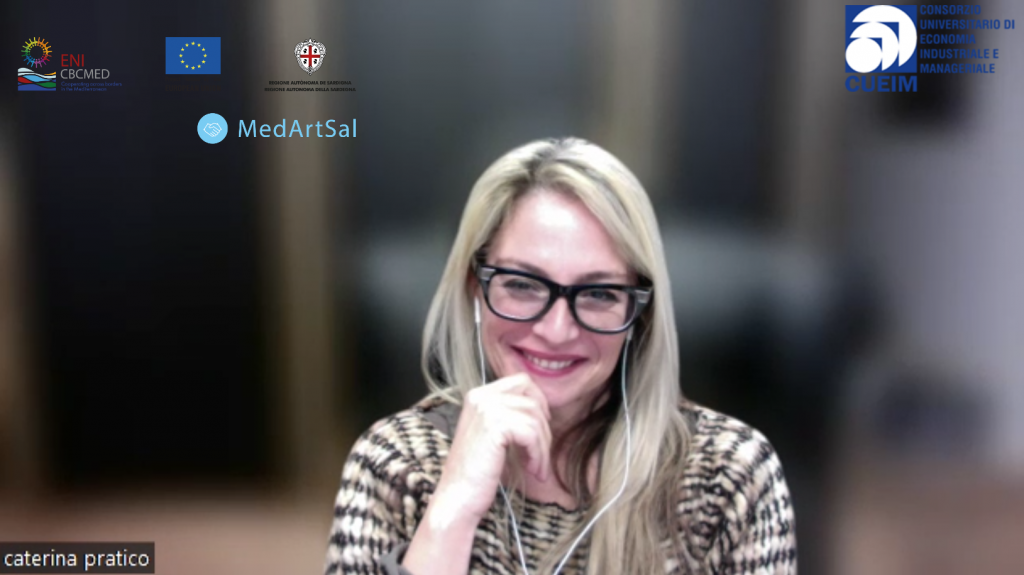
The interview focused on the following aspects: the Interreg Blue Growth circular economy best practices; the importance of the community value to turn results into impacts; lessons learnt about sustainable tourism practices; transferring and capitalization opportunities in the light of the new programming period. The full interview is available on the MedArtSal YouTube channel: https://www.youtube.com/watch?v=B4vla12OiaM.
- 1. The experience of the Interreg Blue Growth Community with circular economy best practices.
Mrs Praticò recently took part at the 2022 UN Climate Change Conference COP27, cooperating with the Green Growth Interreg Med Community referents to the Workshop “Promoting green and blue growth innovation in the Mediterranean: adopting circular economy strategies for climate change mitigation and adaptation” held on 17th November 2022 in Sharm El-Sheikh, Egypt. Building on her relevant contribution, it was firstly interesting to learn more about the Blue Growth Community experience regarding circular economy best practices to tackle climate change. In this sense, Mrs Praticò underlines the great work realised as a Community in collecting, showing and promoting some of the best results got from some of the community projects, such as from the BLUEfasma Circularity Self-Assessment tool (unified Mediterranean measure of the SMEs’ readiness and willingness to invest in CE, acting as a decision support tool) and agreements with institutional authorities (MoU – Alentejo Region - Portugal), which have adopted commitments to implement that tool. This experience shows how important the contribution of the Interreg Med Communities has been in the promotion of circular economy best practices in the Med Area and beyond.
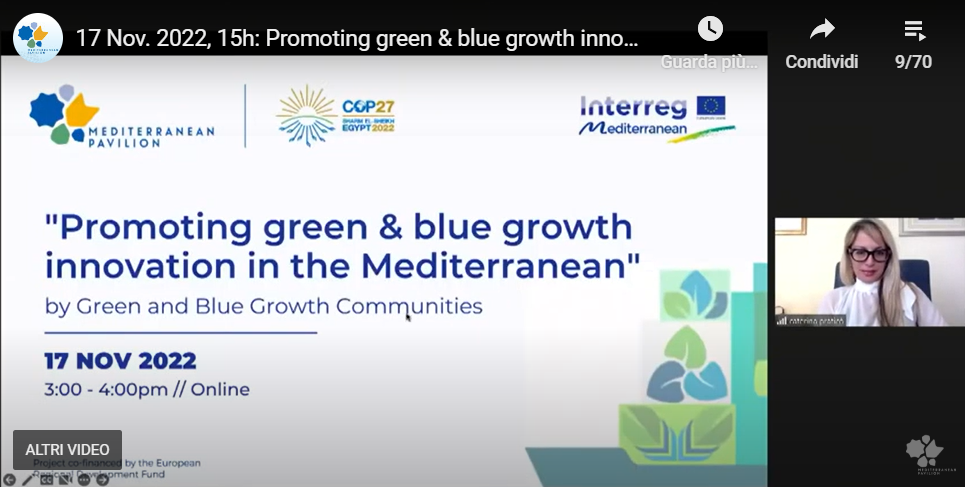
2. The importance of the community value to turn results into impacts.
One of the main common values of the Interreg Med and the ENI CBC Med programmes is the community value, as a strategic approach to pursue their objectives, although in different ways. Likewise, the MedArtSal experience has allowed to build a community of artisanal saltpans throughout the years, which focuses on the added value of their tradition to promote a sustainable business model. We decided to ask Mrs Praticò, as a community of projects representative, how this approach can keep supporting capitalization models in the future, allowing to scale up of the results and to achieve tangible impacts.

Mrs Praticò underlines the success of the experience of Communities and horizontal projects during the Interreg Med programming period, where the 8 Communities worked in order to create synergies between their Modular Projects as well as to ensure the capitalization of their results. The upscaling of this experience to the Interreg Euro Med programme in the new programming period is also a proof of this success. Indeed, a new governance programme will maintain the involvement of all future projects as well as multiple actors, making them able to contribute to the Mediterranean territorial policy and governance issues, increasing their cooperation and so bringing to more relevant results.
3. Lessons learnt about sustainable tourism practices – the MedArtSal sustainable tourism ambitions.
Both projects – Interreg Med Blue Growth and MedArtSal - deal with sustainability in blue (but also not blue) areas. MedArtSal is working to diversify the opportunities for development, where tourism is showing to be an interesting pathway for saltpans (see the experience with the Local Economic Cluster in the Natural Park Bay of Cadiz - Spain – thanks to the application of the MEET Network methodology from the Interreg Med DestiMED project). The Interreg Med Blue Growth also includes among its pillars, one for sustainable tourism (i.e., the BLUEISLANDS project experience could offer interesting insights. It focuses on the effects of the seasonal variation of waste generation on Mediterranean islands as an effect of tourism in the coastal marine areas.). This and other experiences from the Community, show potential to support the capitalisation phase of MedArtSal, to move towards sustainable tourism models.
Mrs Praticò underlines that, even though in the Interreg Med programme there was another specific Community dealing with sustainable tourism (the Interreg Med Sustainable Tourism Community), the relevance of the Blue Growth Community focused areas and issues as well as the consistency with the sustainable tourism component of the Blue Economy, made it possible to address this aspect as a transversal one within its strategy. This strategy, focused on its three main axes of the knowledge of the marine environment, the maritime spatial planning and the integrated maritime surveillance, aims at supporting the sustainable growth of the marine and maritime sectors as a whole. In this sense, the Community made an important contribution to the sustainable tourism goal (both through some of its projects and as a Community), by developing specific instruments such as Guidelines for sustainability of cruises and recreational boating in the Mediterranean Region – April 2022 – and Policy recommendations for a more sustainable Blue Economy, as a contribution to the EU Communication in May 2022 about a new approach for a sustainable Blue Economy in the European Union.
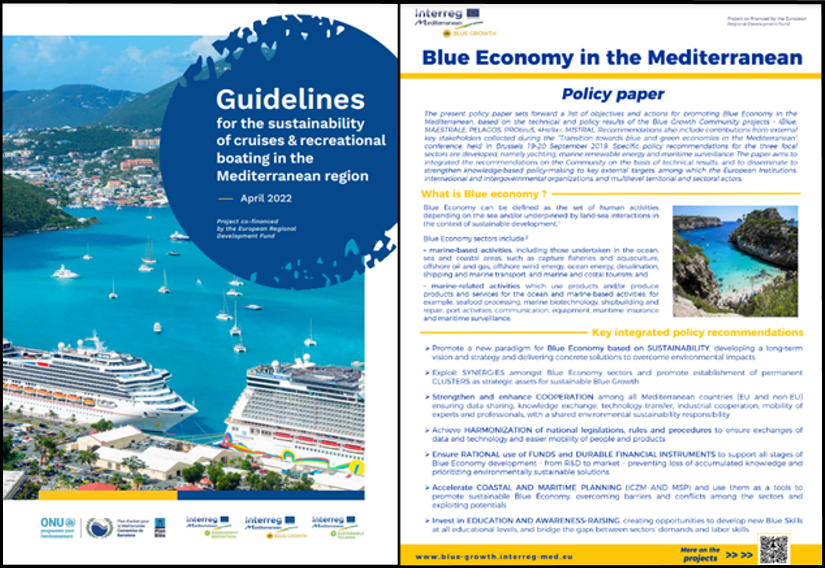
These recommendations are even relevant for coastal and maritime sustainable tourism, as they promote, among others, new models of recreational boating and yachting, aligned with the Cohesion Policy principles, and new business model, looking at the experience at one of the community projects (iBLUE project - 3-PBM methodology) and focus on innovation, competitiveness, environment protection and job creation in the targeted sectors.
4. Transferring and capitalization opportunities in the light of the new programming period.
The mentioned policy recommendations can represent one of the available instruments that the Interreg Blue Growth Community could adopt to keep its experience effective for the future EU actions and programmes. In this sense, considering the opportunities offered by new programmes, such as the Interreg Euro Med and the NEXT MED, the main question would be how to develop practical project proposals, which succeed in capitalizing and transferring this experience.
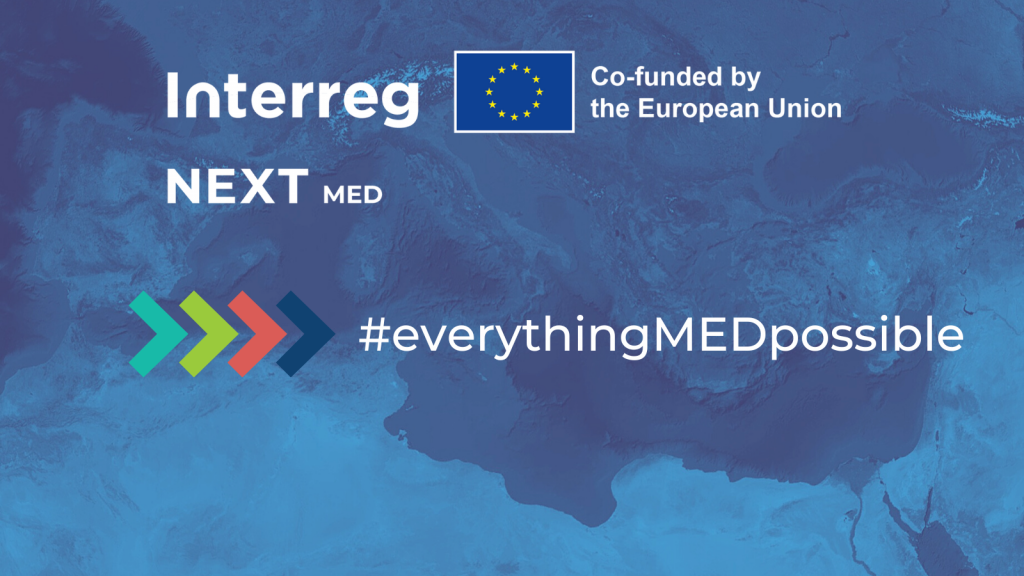
Mrs Praticò takes the chance of this last question to advance some information about the recent project proposals submitted as CoNISMA in the framework of the new Interreg Euro Med programme, as examples of an advisable strategy to effectively meet the new programme objectives. The main idea would be to integrate different experiences, tools and best practices in order to build projects able to capitalize and spread the previous best results to other communities and territories in the Med area. In their specific case, the idea has been to integrate tourism, conservation policies and business activities in specific habitats like saltpans and other productive rural areas which represent a cultural heritage in the Mediterranean, in order to support the sustainable use of natural resources in anthropogenic habitats ecosystems. The joint development of integrated solutions would allow to better promote the sustainable tourism and the preservation and valorisation of ancient and artisanal activities.
Final remarks

The integration approach described by Mrs Praticò raises the issue of focusing on the strategic value of this kind of areas, where, as got from the MedArtSal experience, the best results could be achieved only by making a system between different and relevant involved actors, so pushing on their potential (Oliviero).
Once again, the role of the community value comes back as strategic. Referring to Mrs Praticò speech about this aspect, Mr Zarlenga underlines how working as a Community has been fundamental for CUEIM too, both as MedArtSal Lead Beneficiary and as partner of the Interreg Green Growth Community project.
In the last case, it allowed to create a platform where it has been possible to share and integrate knowledge, experiences and best practices, facilitating the integration of the best results and tools, making them available for new project proposals and so spreading their impact. In the framework of MedArtSal, it has showed that artisanal salinas represent a great opportunity for the development of local territories and communities, so that to replicate this experience together with the Blue Growth Community one could offer a relevant perspective in the future.
Therefore, it would be also important to identify and specify the double value of these areas, as Mrs Campisi underlines, explaining that in MedArtSal the term “salinas” (used by researchers to identify the areas involved by productive human activities) was adopted rather than the “saltpans” one, in order to point out both the productive and the environmental value of these anthropogenic areas and how human activity can have a positive impact on the landscape. This could be another interesting key to better focus on the role of other rural territories that would be involved by new projects in the new programming period.
